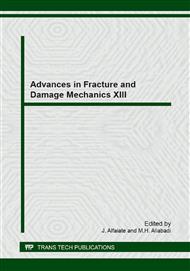p.125
p.129
p.133
p.137
p.141
p.145
p.149
p.153
p.157
The Effect of Specimen Size on the Determination of Residual Stress in Polymer Pipe Wall
Abstract:
As a result of the production process, there are axial and tangential residual stresses present in pressure pipes made of polymer materials such as polyethylene or polypropylene. The residual stress magnitude and distribution have a significant influence on the pipe lifetime. In this contribution the results from experiments focused on determining the tangential residual stress distribution in the walls of polypropylene pipes of different dimensions are compared. The experimental method used involves measuring the deformation of ring shaped specimens that were slit in the axial direction. Measured deformation of the ring specimen is a result of the tangential and axial stress superposition. However, the effect of the axial residual stress depends on the specimen axial dimension and tangential residual stress estimated basing on experimental data should be corrected according to axial dimension of the specimen used. The correction suggested in this article is determined based on three-dimensional FEM simulations of the experiment.
Info:
Periodical:
Pages:
141-144
Citation:
Online since:
September 2014
Authors:
Price:
Сopyright:
© 2015 Trans Tech Publications Ltd. All Rights Reserved
Share:
Citation:


